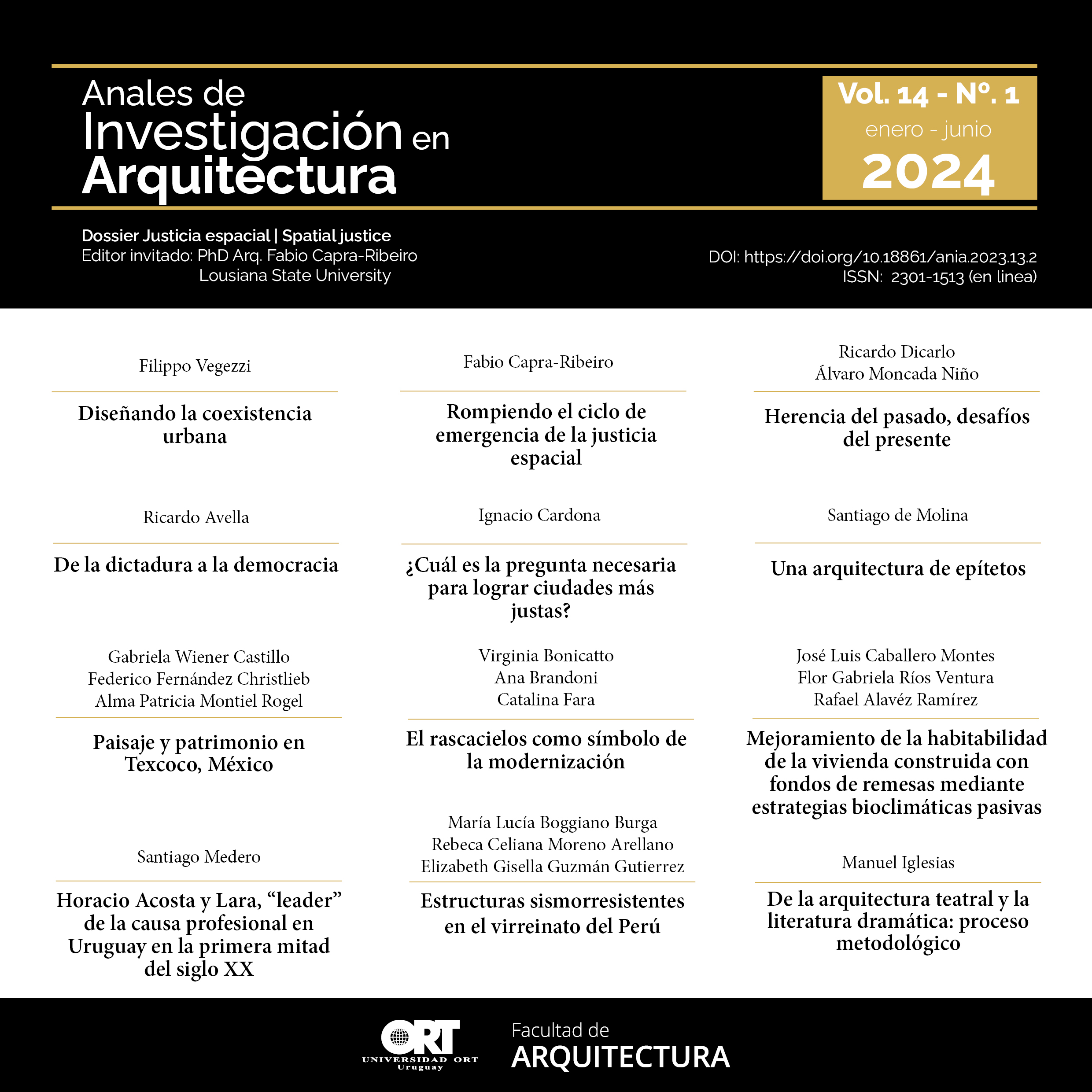Seismic-resistant structures in the viceroyalty of Peru
Quincha vaults in the main churches of Trujillo
DOI:
https://doi.org/10.18861/ania.2024.14.1.3758Keywords:
churches of Trujillo, cultural heritage, peruvian architecture, seismic-resistance, vault encamonada, vault of quincha, Viceroyalty of PeruAbstract
Since the beginning of the Spanish occupation in Peru in the sixteenth century and after the process of transculturation, a great variety of walls, arches and vaults were built with sizes similar to those executed in the Iberian Peninsula. At the beginning, these works were made with brick, stone and adobe; however, with the frequent earthquakes that made collapse much of these buildings, the lack of constructive foresight of the Spanish alarifes was evident. Therefore, they had to resort to the quincha, material made of wooden grids, cane, and mud cover that was used in the construction of pre-Hispanic housing and administrative centers. The present research shows the results of a field work, descriptive, complete bibliographic review that aimed to demonstrate the origin and evolution of quincha vaults in Peru; the seismic resistance of the material, as well as the structural effectiveness it had in the construction of the vaults and domes of the main churches of Trujillo. The results allow a greater understanding of the viceroyalty architecture and evidence its ancestral usefulness in the modern context, as well as its captivating aesthetic that allows the identification of the trujillano with its cultural heritage.
Downloads
References
Arce Blanco, M. (2017). Estudio de las bóvedas encamonadas en Madrid capital y análisis de su comportamiento estructural. [Tesis Doctoral, Universidad Politécnica de Madrid] https://doi.org/10.20868/UPM.thesis.48247
Bustamante, R. y Monjo, J. (2012). “La solución constructiva de la bóveda encamonada del salón de plenos del palacio del Senado en Madrid”. En Informes de la Construcción, vol. 64. 109-120. https://doi.org/10.3989/ic.11.044
Instituto Nacional de Cultura. (2000). Templos, conventos y cementerios declarados patrimonio cultural. [Archivo PDF]. https://bit.ly/3OIgefL
Correa-Orbegoso, J. y De Mesa, J. (2011). Barroco y policromía. Las casas de Trujillo del Perú. En I Encuentro internacional sobre Barroco Andino. (pp. 149-159). GRISO-Universidad de Navarra. https://dadun.unav.edu/handle/10171/17965
De Villanueva, L. (2005). Bóvedas de madera. En IV Congreso Nacional de Historia de la Construcción. (pp. 1103-1113). Madrid: Instituto Juan de Herrera. https://www.sedhc.es/biblioteca/acta.php?id_act=5&id_cng=5
Díaz, F. (2014). Los diez libros de arquitectura de Vitruvio, en la traducción de José Ortiz y Sanz. Alicante: Biblioteca Virtual Miguel de Cervantes. https://www.cervantesvirtual.com/nd/ark:/59851/bmcvq4v0
González, D. (2007). Vocabvlario de la Lengva General de todo el Perv llamada Lengua Qquichua, o del Inca [Archivo PDF]. Lima: Runasimipi Qespisqa. http://www.letras.ufmg.br/padrao_cms/documentos/profs/romulo/VocabvlarioQqichuaDeHolguin1607.pdf
Hurtado-Valdez, P. (2007). Estructuras antisísmicas: las bóvedas encamonadas en el Virreinato del Perú. En: V Congreso Nacional de Historia de la Construcción. (pp. 533). Madrid: Instituto Juan de Herrera.
Hurtado-Valdez, P. (2011). Bóvedas encamonadas: Origen, evolución, geometría y construcción entre los siglos XVII y XVIII en el Virreinato de Perú. [Tesis Doctoral, Universidad Politécnica de Madrid.] https://doi.org/10.20868/UPM.thesis.10714
Hurtado-Valdez, P. (2015). “Criterios de sismorresistencia y cálculo tradicional de estructuras en la arquitectura limeña del Siglo XVII.” En Actus. Arquitectura, Cultura, Tecnología, Urbanismo y servicio, vol. 1, n° 1, 115-133. https://revistas.upeu.edu.pe/index.php/r_actus/article/view/927
Kubler, G. (1968). “El problema de los aportes europeos no ibéricos en la arquitectura colonial latinoamericana”. En Boletín del Centro de Investigaciones Históricas y Estéticas, vol. 9, 104-116.
López, C. y Ruiz, D. (2010). “Bóvedas de madera y bahareque en iglesias coloniales bogotanas: Estudio de cuatro iglesias del siglo XVII”. En Apuntes: Revista de Estudios sobre Patrimonio Cultural, vol. 23, n° 1, 70-83. http://hdl.handle.net/10554/23225
Marussi, F. (1986). “Bóvedas a base de quincha en las edificaciones monumentales del virreinato del Perú”. En Informes de la Construcción, vol. 37, n° 377, 59-66. https://informesdelaconstruccion.revistas.csic.es/index.php/informesdelaconstruccion/article/view/1789
Nuere, E. (2000). La carpintería de armar española. Madrid: Editorial Munilla-Lería. ISBN: 9788489150379.
San Cristóbal, A. (1993). “Los Alarifes en la ciudad de Lima durante el siglo XVII”. En Laboratorio de arte, n°6, 129-155. https://doi.org/10.12795/LA.1993.i06.06
San Cristóbal, A. (1995). “Las bóvedas de Quincha en la Iglesia del Prado en Lima”. En Laboratorio de arte, n°8, 175-192. https://doi.org/10.12795/LA.1995.i08.09
San Cristóbal, A. (1997). “Una teoría sobre la invención de las bóvedas de quincha”. En Histórica, vol. 21, n° 2, 293-315. https://doi.org/10.18800/historica.199702.007
Seiner, L. (2009) Historia de los sismos en el Perú. Catálogo: Siglos XV-XVII. Lima: Universidad de Lima. ISBN 978-9972-45-232-1.
Schilder, C. (2000). La herencia española: las bóvedas y cúpulas de quincha en El Perú. En III Congreso Nacional de Historia de la Construcción. (pp. 1019-1026). Madrid: Instituto Juan de Herrera. https://idus.us.es/handle/11441/67401
Tomasi, J. y Bellmann, L. (2019). La quincha y los sistemas de entramados. En Estructuras, n°1, 28-34. https://revistas.unc.edu.ar/index.php/estructuras/article/view/24741
Velasco, M. (2016). La casa virreinal limeña. En XIII CIATTI. Arquitectura en tierra. Historia y Renovación. Valladolid: Universidad de Valladolid, pp. 81-86. https://www5.uva.es/grupotierra/publicaciones/digital/libro2017/07XIIICIATTI2016_Velasco.pdf
Downloads
Published
How to Cite
Issue
Section
License
Copyright (c) 2023 María Lucía Boggiano Burga, Rebeca Celiana Moreno Arellano, Elizabeth Gisella Guzmán Gutierrez

This work is licensed under a Creative Commons Attribution 4.0 International License.
The journal and its contents are licensed under the Creative Commons - Attribution 4.0 International License (CC BY 4.0). It is possible to copy, communicate and publicly distribute its content as long as the individual authors and the name of this publication are cited, as well as the publishing institution (Universidad ORT Uruguay).


